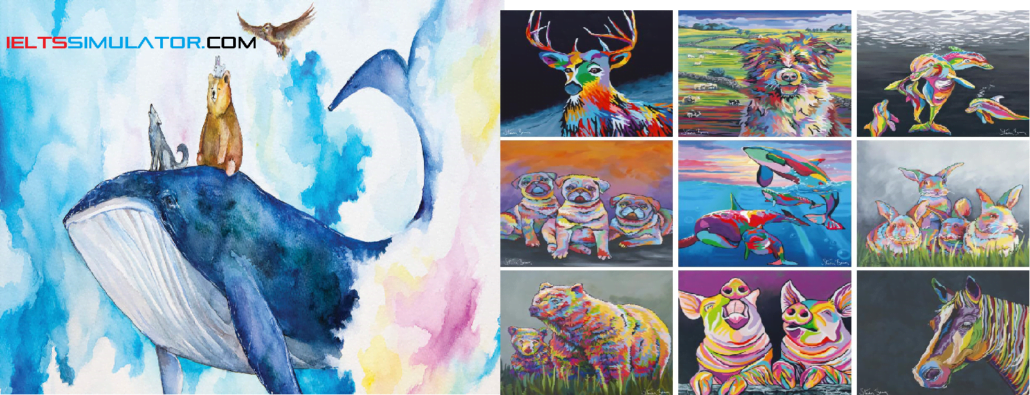
IELTS LISTENING S65T4
ANIMAL ART
Lecturer: I have just shown you all some slides of a very varied set of paintings. I noticed as I was showing the slides, a few giggles in the audience and a few looks of dismay. I guess, entitling my lecture ‘Unconventional Art Geniuses’ was a bit misleading. When most of you were looking at the frankly Q31 basic colour use and rather primitive painting techniques, you probably were more than a little surprised.
Attempt full listening test…
Well… I have a shock for you all. What I’m about to tell you next will help you understand the title of my lecture. All the slides I showed you previously are of artworks made by… wait for it… animals! Yes, I heard a few gasps In the audience when I said that. Whilst the artwork would be definitely primitive by Q32 human standards, when you consider that the artworks were executed by animals, then, well, they are frankly staggering! Nor were the artworks purely the work of our Q33 closest relatives, the apes. No, they were produced by animal artists, drawn from a diverse pool of species, ranging from elephants to gorillas, birds, and even sloths! In fact, Q34 in recognition of this, last year, London’s Grant Museum of Zoology staged what organisers thought was the first Inter-species show of paintings by animals. In the show, art was shown from an orangutan, a gorilla, and an elephant. Whilst the gorilla and the orangutan produced works that bore a resemblance to the paintings of modern artists de Kooning and Kline, the elephant’s work took a more Q35 figurative approach in the rendering of a flower pot.
Now before you all go thinking this is a revolutionary discovery, I would like to put the record straight. The contribution animals can make to the art world was highlighted as far back as the 1950s. In this decade, Desmond Morris, celebrated social anthropologist and author of bestsellers, such as ‘Bodywatching’ and ‘The Naked Ape’, Introduced Congo the painting Chimp to the British public in a TV appearance. Back then, animal art-makers were regarded as little more than a Q36 novelty. Today, however, animal artists are not viewed so much as novelties but as sophisticated creators with skills and senses that they use to execute artworks in ways humans never can.
As a result of animals being taken more seriously as creators of art, it has become commonplace today for zoos to provide materials to captive animals. The hope is that by giving animals the means to create art, they will be kept physically and mentally stimulated. Obviously, you can’t give a lizard a paintbrush and expect it to draw! What the zookeepers do, though, is to give animals species-appropriate art materials and Q37 tools. For example, sloth bears, who feed by blowing away dirt from the forest floor to feed on termites, have been given a straw-like apparatus to blow paint onto a canvas.
What is one of the most interesting discoveries to come out of all this, though, is the finding that animals voluntarily and Instinctively participate in the creation of art. It seems therefore that animals derive as much pleasure as humans do in applying paint to canvas or making a clay or plasticine figure. The obvious conclusion to draw from all this Is that there are Q38 more similarities between Man and other animals than some of us might care to admit. However, just to satisfy the sceptics amongst you, there is something I would like to add. So far, the primate and elephant art that has been produced often bears an uncanny resemblance to Western art. Certain conventions are evident In the animals’ art that suggest a degree of Q39 human intervention. As proof of this, an elephant named Boon Mee was actually guided by a keeper who steered the animal’s trunk to paint brushstrokes on a canvas! Nevertheless, we should keep an Q40 open mind about animal art as there are just as many examples of artworks that have been completed by animals without human aid.
Attempt full listening test…